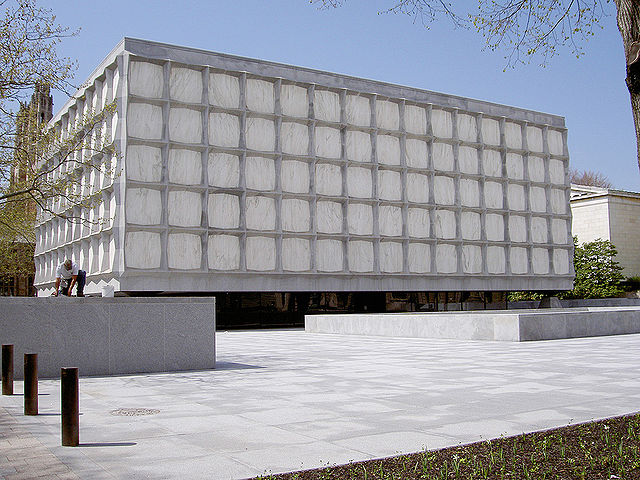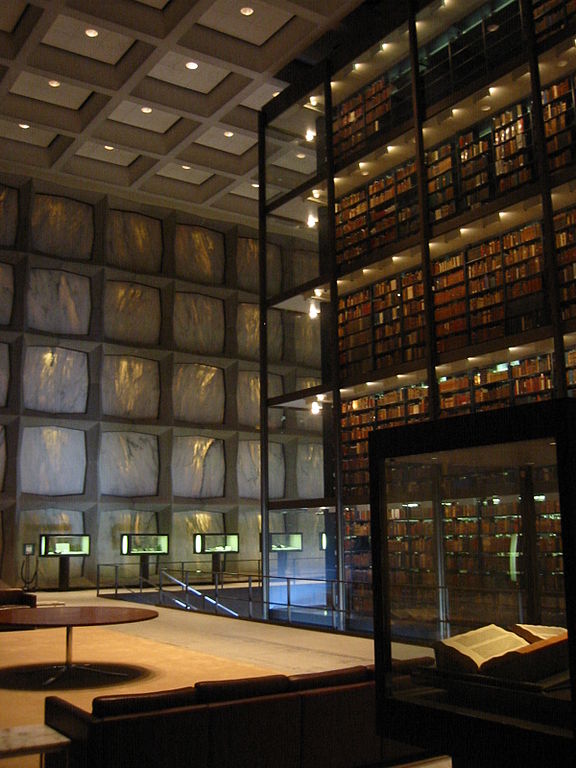The Sun Never Rises

Pictured above is the Beinecke Rare Book and Manuscript Library, a now 50 year-old building gracing the campus of Yale University in New Haven, Connecticut. The Beinecke Library is home to 500,000 volumes of rare books and “several million” manuscripts, per its Wikipedia entry, making it one of the largest (if not the largest) repositories dedicated to the collection and preservation of rare writings. Among the documents housed therein are an original Gutenberg Bible and, as discussed in these pages earlier, the Voynich manuscript.
Hopefully, the documents will be around for a while, but that’s not a given. One of the biggest problems with caring for old books is that the paper (or other materials) they’re written on will, over time, disintegrate. The library’s job? Slow down that process as much as possible. The solutions: gas, freezers, and stone.

Inside the building is a glass-enclosed column of some of the more valuable books in the collection, as seen above. That collection is typically off-limits, with librarians the only ones with regular access. The column is outfitted with a fire-retardation system which floods the area with oxygen-depriving gases if the alarms go off — you can’t use water or the books would get ruined. (This led to a rumor that, if the fire alarms were to sound, the librarians would be trapped inside to suffocate to death. The rumor is, thankfully, false.)
Similarly, the glass tower is air-tight to slow disintegration due to exposure from external elements. Unfortunately, this feature led to an unintended consequence. In the 1970s, bookworms (not students of old texts, but actual insects which eat books) infested the column, and according to the Yale Daily News, the typical solution — an airborne insecticide — wasn’t viable in an enclosed, air-tight space. Instead, the librarians had to go to extremes — extreme temperatures, that is. They decided, successfully, to freeze (and then thaw) all the books. As a precaution, all the new ones introduced to the area still go through that same process.
But bookworms and exposure to air aren’t the the only major threats to centuries-old manuscripts. Exposure to direct sunlight hastens the aging process, and if you’re a curator of such documents, that’s something best avoided. At the same time, keeping the books and documents in a building with no natural light means that you consume a lot of electricity and make for a bad place to study or read. Gordon Bunshaft, the architect behind the building, came up with a solution — change the windows. They aren’t made of glass. They’re made of stone — translucent marble which glows when illuminated but protects the interior from direct sunlight. (Here’s a great picture.) During the day, the Beinecke Library’s walls turn amber if you’re inside, as seen in the second image above. And at night, the internal artificial lighting results in the same glowing effect, but this time on the building’s exterior, visible to passersby.
As a bonus? The design of the library and particularly, its marble windows, allows librarians to keep the Beiniecke’s copy of the Gutenberg Bible on display, seen here.
Bonus Fact: According to Wikipedia, pill bottles are often orange for similar reasons as the above — “to prevent light from degrading the potentially photosensitive contents” of the bottle.
From the Archives: Mystery Tome: The story of the Voynich Manuscript, noted above.
Related: Stones that work like ice cubes. Sorry, they aren’t translucent, and they won’t give your drink an amber glow.
